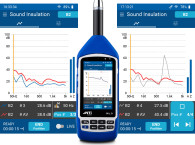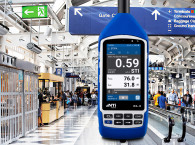
NTi's XL2 Acoustic Analyzer in combination with the 'Sound Insulation Reporter' PC-software offers a professional and intuitive building acoustics measurement solution. The sound reduction index, a measure of the sound insulation provided by a partition between two rooms, is determined precisely and in accordance with the relevant ISO or ASTM standards. In order to determine the sound reduction index, an excitation signal is generated (from an airborne or impact sound source) on one side of the partition and the reduction in sound across the partition is determined by measuring the sound levels with an XL2 in both the source and receiving rooms.
For consultants infrequently called on to carry out sound insulation measurements, one XL2 with its associated microphone would be a sufficient system configuration for the assessment. The process is to firstly measure the average level in the source room then measure the average level in the receiving room. Finally, connecting the XL2 to a PC via the USB interface, allows manually loading the results into the Sound Insulation Reporter PC-software for immediate reporting.
Where there is an increasing requirement to undertake sound insulation tests, investing in a second XL2 and microphone may offer significant benefits for both site-based and laboratory-based measurements. The consultant can then simultaneously connect both XL2s to one PC via USB. Set up one microphone in the source room and one in the receiving room, and perform both measurements simultaneously with a single push of a button in the Sound Insulation Reporter software.

Running the microphone cable between adjacent rooms may be too far for the cable length available, too difficult or downright impossible. If, for example, there is no underfloor cable channel, then leaving the connecting door between the rooms even slightly open to run the cable can have a significant detrimental influence on the results. A Wi-Fi Access Point can solve this. The XL2 along with the associated microphone are positioned in the remote room and connected via USB to a Wireless USB Device Server. The Sound Insulation Reporter software then simultaneously receives both wireless and USB signals from the two (or even more) XL2s. Eliminating cables in this way can often be essential for good measurement integrity, while also offering notable improvements in efficiency.
The latest version of the 'Sound Insulation Reporter' software also makes it possible to determine the airborne sound insulation of facades or facade components. For example, the airborne sound insulation of windows can be quickly assessed and compared with alternative window types or installation methods. The assessment is carried out in accordance with ISO 16283, ISO 140, ASTM E966, GB / T 19889 or SIA 181 standards.


The ‘Sound Insulation Reporter' PC-software can be installed freely on any number of computers, so that measurements can be evaluated on-site on a notebook PC as well as post-processed on the office PC. For building acoustic assessments the 'Extended Acoustic Package' and 'Sound Insulation Reporter' Options are required options on the XL2. For users who only occasionally perform building acoustic measurements, an alternative to the permanent license for 'Sound Insulation Reporter' is an inexpensive annual license. For the remote control of the XL2 and live display of the spectra on the PC, the 'Remote Measurement' Option is also required on the XL2. The minimum XL2 firmware version for automated sound insulation testing is V3.33 or higher. This is available to download for free to registered users.
www.nti-audio.com/en/solutions/building-acoustics.aspx






